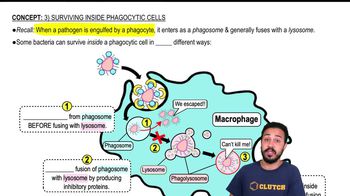Thermal death point is not considered an accurate measure of the effectiveness of heat sterilization. List three factors that can alter thermal death point.
Differentiate cellular and plasmodial slime molds. How does each survive adverse environmental conditions?
 Verified step by step guidance
Verified step by step guidance
Verified Solution
Key Concepts
Cellular Slime Molds

Plasmodial Slime Molds

Survival Strategies

The antimicrobial effect of gamma radiation is due to (a) ________. The antimicrobial effect of ultraviolet radiation is due to (b) ________.
A mixed culture of Escherichia coli and Penicillium chrysogenum is inoculated onto the following culture media. On which medium would you expect each to grow? Why?
a. 0.5% peptone in tap water
b. 10% glucose in tap water
Match the following choices to the culture descriptions in questions 3 through 6:
a. Chlamydia
b. Coccidioides
c. Histoplasma
d. Mycobacterium
e. Mycoplasma
This pneumonia etiology requires cell culture.
Match the following choices to the culture descriptions in questions 3 through 6:
a. Chlamydia
b. Coccidioides
c. Histoplasma
d. Mycobacterium
e. Mycoplasma
Microscopic examination of a lung biopsy shows ovoid cells in alveolar macrophages. You suspect these are the cause of the patient’s signs and symptoms, but your culture grows a filamentous organism.
Match the following choices to the culture descriptions in questions 3 through 6:
a. Chlamydia
b. Coccidioides
c. Histoplasma
d. Mycobacterium
e. Mycoplasma
Microscopic examination of a lung biopsy shows spherules.
